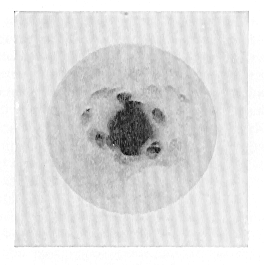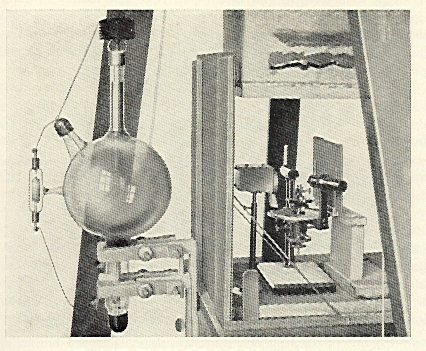 |
In the Beginning |
 |
In the Beginning |
In the Beginning
Powder diffraction is virtually as old as X-ray diffraction itself. The phenomenon of X-ray diffraction (which is explained later in this section) was discovered by Laue, with his co-workers Friedrich and Knipping, in 1912 for which he was rightly awarded the Nobel prize. The discovery was made using a single crystal of Copper Sulphate Hydrate. The actual diffraction pattern obtained was pretty awful (see below) with vague smudges instead of sharp diffraction spots, and the apparatus used (see also below) was quaintly primitive by modern standards.
 |
 |
| Laue's first
diffraction pattern |
Apparatus Laue used |
However the importance of the discovery was fairly apparent even at the time; in hindsight we can see that indeed it was one of the most important scientific events of the 20th century, since so many subsequent discoveries, from super-conductors to DNA, have relied on diffraction for their elucidation. One only has to read through the accounts of these events (e.g. Fifty Years of Diffraction by P.P.Ewald) to sample the feeling of awe that the main players experienced as the story unfolded: the walk through the park where Laue and Ewald first discussed the experimental and theoretical possibilities, the Cafe Lutz where the three planned the first diffraction experiment, and after the great event the precise house and street that Laue walked passed as he suddenly realised the profound implications of the result; these details are all recorded, as though the main characters realised the historical acts they were playing.
Soon after, it was realised that poly-crystals could equally sustain diffraction and further that a mass of small crystallites was a particularly convenient form for a sample: such a sample became known as a powder due to its texture. By the end of the last century we had seen nearly 90 years of powder diffraction, a period which brought enormous technological changes to powder diffraction apparatus, though many of the basic principles of operation remain the same.
|
© Copyright 1997-2006.
Birkbeck College, University of London.
|
Author(s):
Paul Barnes Tony Csoka |